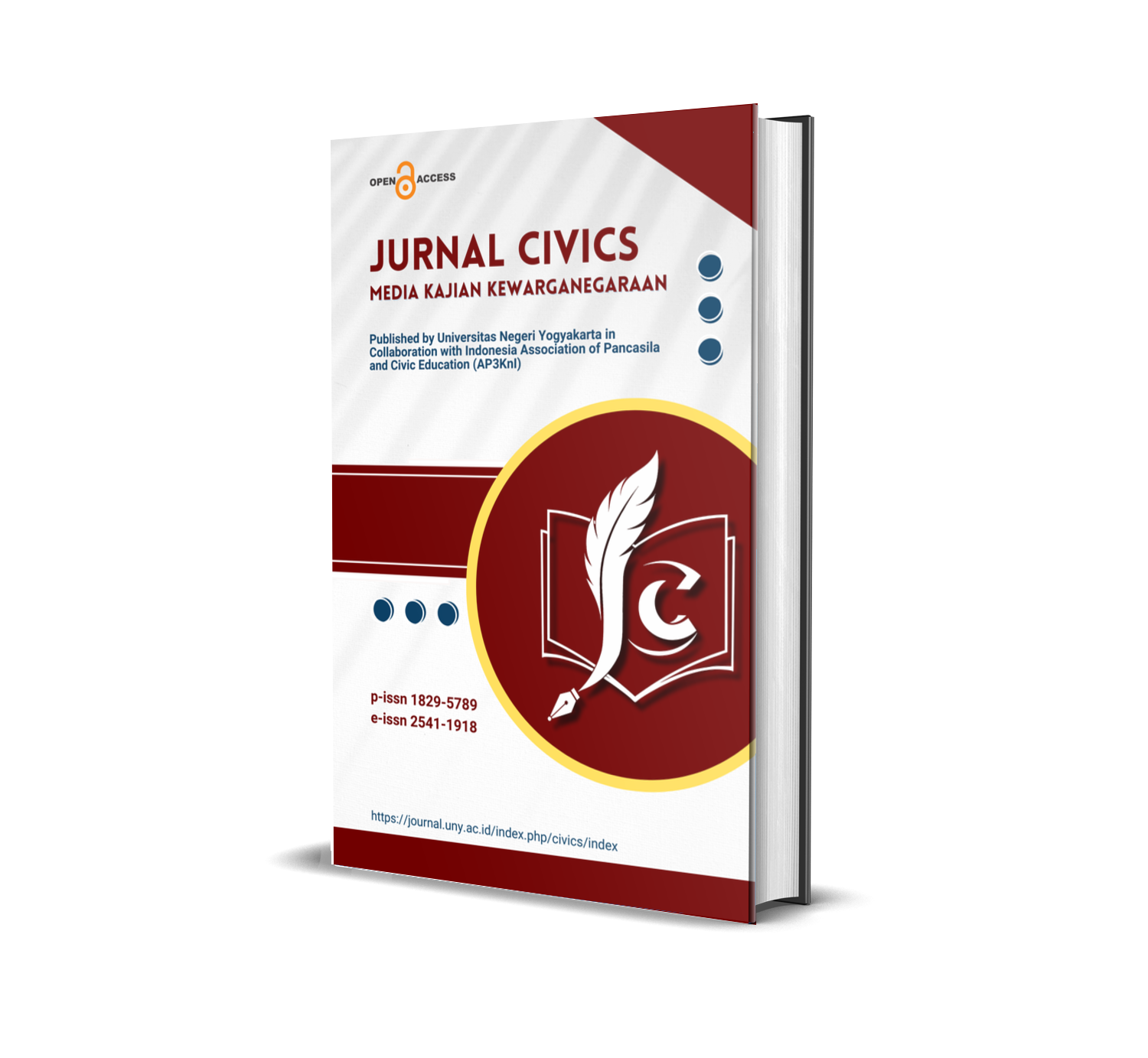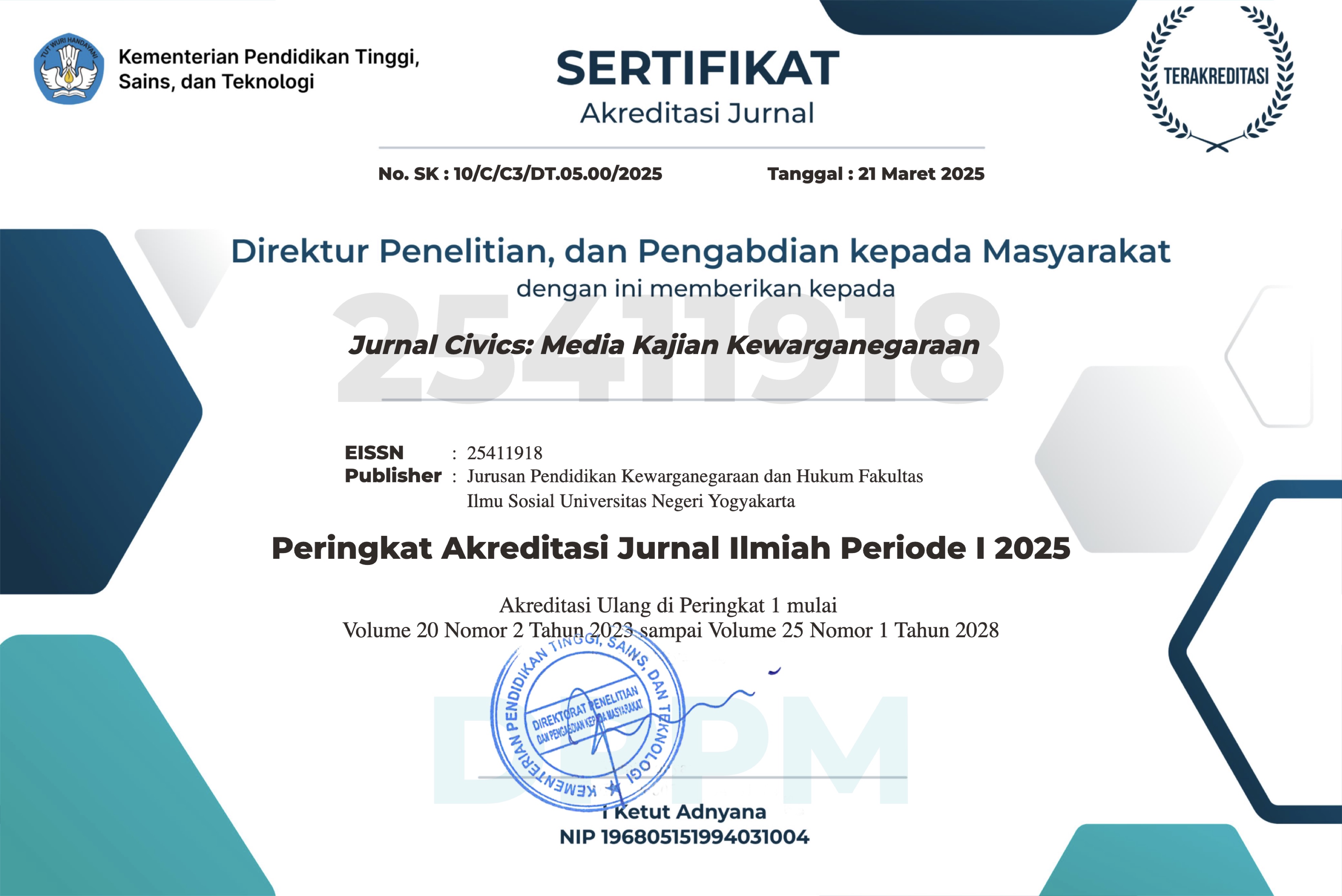Penumbuhan kemampuan berpikir kritis PKn melalui model numbered head together
DOI:
https://doi.org/10.21831/jc.v16i2.21518Keywords:
critical thinking, problem based learningAbstract
Kegiatan pembelajaran dengan model numbered head together (NHT) dilaksanakan untuk meningkatkan aspek kognitif dalam pembelajaran PKn. Aspek ini dapat dikembangkan dengan menanamkan kemampuan berpikir kritis siswa. Model NHT merupakan suatu model pembelajaran yang mengutamakan antusias siswa dalam mencari, mengolah, dan mempresentasikan hasil informasi yang telah diperoleh di depan kelas berdasarkan nomor yang diperoleh oleh masing-masing siswa. Langkah pembelajaran model NHT diantaranya: 1) siswa dibagi menjadi beberapa kelompok kecil, 2) setiap siswa mendapatkan nomor yang berbeda, 3) guru memberi tugas pada masing-masing kelompok, 4) siswa diminta menyelesaikan dan mendiskusikan jawaban bersama kelompok masing-masing, 5) guru memanggil salah satu nomor, kemudian siswa yang memperoleh nomor keluar dari kelompoknya dan menjelaskan tugas yang telah dikerjakan di depan kelas, 5) kelompok yang tidak mendapatkan giliran memberikan tanggapan dan masukkan kepada kelompok yang maju, 6) siswa bersama guru menyimpulkan hasil pekerjaan mereka.
This learning activity carried out to reveal the cognitive aspects of learning civics. This aspect can be developed by teaching students' critical thinking skills. The NHT is a learning model that prioritizes students' enthusiasm in searching, processing, and presenting the results of information that has obtain in front of the class based on the numbers obtained by each student. The learning step of the NHT model are as follows: 1) students are divided into small groups, 2) each student gets a different number, 3) teacher give an assignment to each group, 4) students ask to complete and discuss answers with the group respectively, 5) the teacher calls one of the numbers, then the students who gets the teaching comes out of the group and explains the assignment that has been done in front of the class, 6) student and teacher summarizes the results of their work together.
References
Afifaf, A., & Fibriyani, V. (2016). Implementation of cooperative learning model of numbered heads together (NHT) type on the subject of statistics at vocational hight school. In Proceeding International Conference on Islamic Education (Icied) "Innovations, Approaches, Challenges, and the Future" (Vol. 4, hal. 1–15).
Anderson, L. W., & Krathwol, D. R. (Ed.). (2010). Kerangka landasan pembelajaran, pengajaran dan asesmen. Yogyakarta: Pustaka Pelajar.
Arends, R. I. (2008). Belajar untuk mengajar. (H. P. Soetjipto & S. M. Soetjipto, Penerj.). Yogyakarta: Pustaka Pelajar.
Bezanilla, M. J., Fernández-Nogueira, D., Poblete, M., & Galindo-Domínguez, H. (2019). Methodologies for teaching-learning critical thinking in higher education: The teacher's view. Thinking Skills and Creativity, 33(June), 100584. https://doi.org/10.1016/j.tsc.2019.100584
Brookfield, S. D. (2012). Teaching for critical thinking: tools and techniques to help students question their assumptions. San Francisco: John Wiley & Sons, Inc.
Brookhart, S. M. (2010). How to assess higher-order thinking skills in your classroom. Alexandria, VA: ASCD.
Brookhart, S. M., & Nitko, A. J. (2019). Educational assessment of students (8th ed.). New York: Pearson Education, Inc.
Choy, C., & Cheah, P. K. (2009). Teacher perceptions of critical thinking among students and its influence on higher education. International Journal of Teaching and Learning in Higher Education, 20(2), 198–206. Diambil dari http://www.isetl.org/ijtlhe/
DoÄŸanay, A. (2012). A curriculum framework for active democratic citizenship education. In M. Print & D. Lange (Ed.), School, curriculum and civic education for building democratic citizens (hal. 19–39). Roterdam, Boston, Taipe: Sense Publisher.
Ennis, R. H. (1989). Critical Thinking and Subject Specificity: Clarification and Needed Research. Educational Researcher, 18(3), 4–10. https://doi.org/10.3102/0013189X018003004
Facione, P. A. (1990). Critical thinking: a statement of expert consensus for purposes of educational assessment and instruction. Millbrae, CA: The California Academic Press.
Fibriyani, A. A. V., & Fibriyani, V. (2017). ani afifah & vita febriyani, 2, 356–360.
Girod, R. J. (2015). Logical investigative methods: critical thinking and reasoning for successful investigation. Logical Investigative Methods. Boca Raton, London, New York: CRC Press. https://doi.org/10.1201/b17482
Halpern, D. F. (2013). Thought and knowledge: an introduction to critical thinking. New York: Psychology Press. https://doi.org/10.1017/CBO9781107415324.004
Leasa, M., & Corebima, A. D. (2016). The effect of numbered heads together (NHT) cooperative learning model on the cognitive achievement of students with different academic ability. Journal of Physics: Conference Series, 755(1), 1–10. https://doi.org/10.1088/1742-6596/755/1/011001
Lu, D., & Xie, Y. (2019). The effects of a critical thinking oriented instructional pattern in a tertiary EFL argumentative writing course. Higher Education Research and Development, 38(5), 969–984. https://doi.org/10.1080/07294360.2019.1607830
Lumsdaine, E., Lumsdaine, M., & Hollander, M. A. (1995). Creative problem solving: thinking skills for a changing world. New York: McGraw-Hill. Diambil dari https://books.google.co.id/books?id=LqBWAAAAYAAJ
Maheady, L., Michielli-Pendl, J., Harper, G. F., & Mallette, B. (2006). The effects of numbered heads together with and without an incentive package on the science test performance of a diverse group of sixth graders. Journal of Behavioral Education, 15(1), 25–39. https://doi.org/10.1007/s10864-005-9002-6
Masek, A., & Yamin, S. (2011). The effect of problem based learning on critical thinking ability : a theoretical and empirical review. International Review of Social Sciences and Humanities, 2(1), 215–221.
Odom, S. F., Shehane, M., Moore, L. L., & McKim, B. (2014). An analysis of a high-impact field experience in agriculture: documenting critical thinking skills through reflection. NACTA Journal, 58(3), 214–220. Diambil dari http://search.proquest.com/docview/1613182443?accountid=8555%5Cnhttp://vp9py7xf3h.search.serialssolutions.com/?ctx_ver=Z39.88-2004&ctx_enc=info:ofi/enc:UTF-8&rfr_id=info:sid/ProQ%3Aeducation&rft_val_fmt=info:ofi/fmt:kev:mtx:journal&rft.genre=article&rft.j
Ormrod, J. E. (2008). Psikologi pendidikan: membantu siswa tumbuh dan berkembang. (W. Indianti, Penerj.). Jakarta: Erlangga.
Shaw, A., Liu, O. L., Gu, L., Kardonova, E., Chirikov, I., Li, G., ... Loyalka, P. (2019). Thinking critically about critical thinking: validating the Russian HEIghten® critical thinking assessment. Studies in Higher Education, 5079. https://doi.org/10.1080/03075079.2019.1672640
Shoimin, A. (2014). 68 model pembelajaran inovatif dalam kurikulum 2013. Yogyakarta: Ar-Ruzz Media.
Slavin, R. (1995). Cooperative learning: Theory, research, and practice. Boston: Allyn and Bacon.
Stobaugh, R. (2013). Assessing critical thinking in middle and high schools: Meeting the common core. London: Routledge. https://doi.org/10.4324/9781315853451
Wilson, K. (2016). Critical reading, critical thinking: Delicate scaffolding in English for Academic Purposes (EAP). Thinking Skills and Creativity, 22, 256–265. https://doi.org/10.1016/j.tsc.2016.10.002
Downloads
Published
How to Cite
Issue
Section
Citation Check
License
The authors agree to transfer the transfer copyright of the article to The Jurnal Civics: Media Kajian Kewarganegaraan effective if and when the paper is accepted for publication.
Authors and other parties are bound to the Creative Commons Attribution-NonCommercial-ShareAlike 4.0 International License for the published articles, legal formal aspect of journal publication accessibility refers to Creative Commons Attribution-NonCommercial-ShareAlike 4.0 International License (CC BY-NC-SA).










